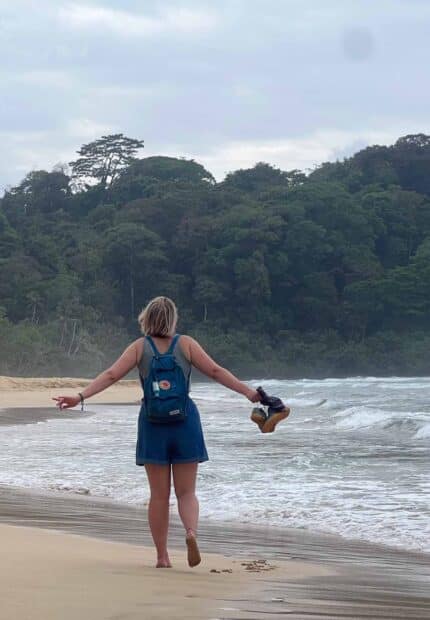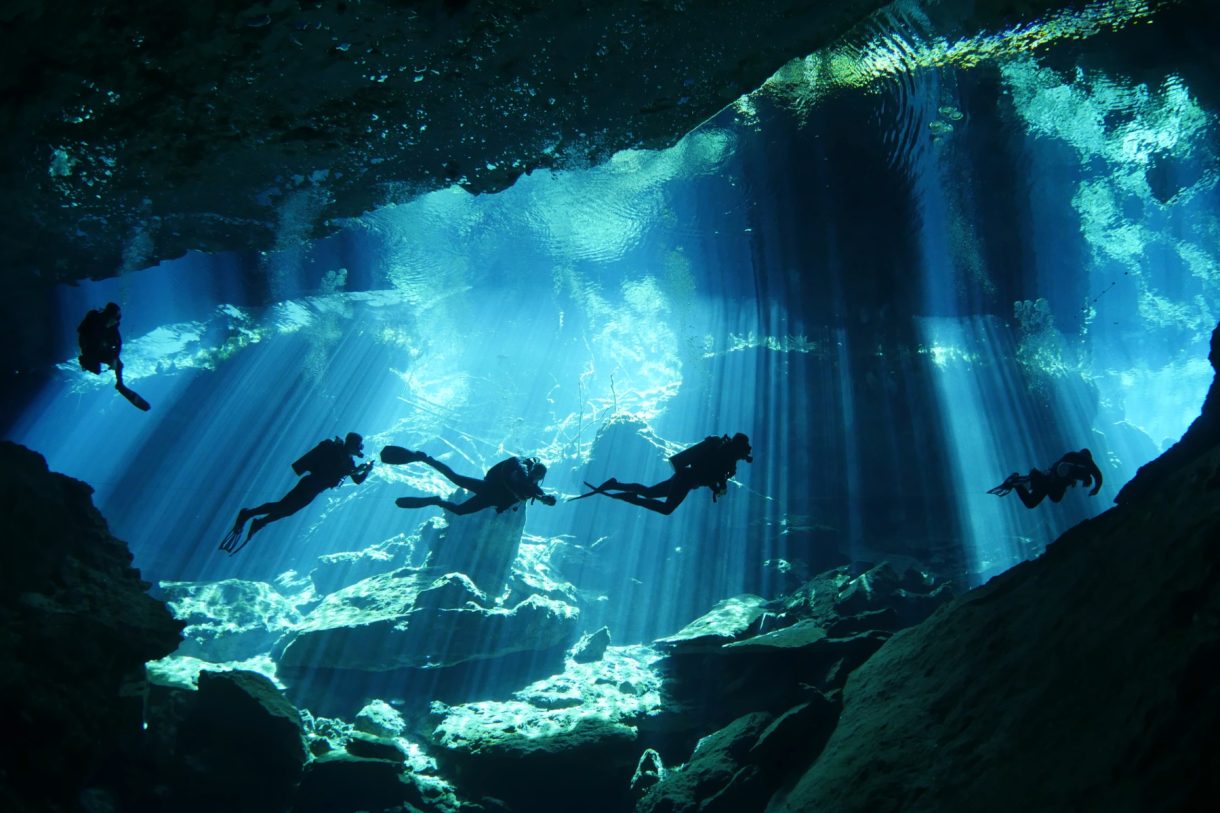
From Mexico to Panama: the ultimate guide to diving in Central America
Central America, along with southern parts of Mexico, offers some of the world’s best diving.
There’s so much to see! From Panama’s Coiba Islands in the Pacific (the ‘Central American Galapagos’) to the Mesoamerican Barrier Reef stretching from Mexico to Honduras on the Caribbean side, Central America is a truly diverse diving destination.
So we’ve compiled this comprehensive dive guide for each country in Central America, plus Mexico. We’ll outline popular dive sites, wildlife to look out for, and expected costs, and suggest the best places to get qualified if you want to do any PADI or SSI certifications.
Most long-term travellers start in Mexico, and work their way south towards Panama, before jumping on a boat to Colombia. Of course, it’s entirely possible to work south to north – we did! But for the sake of this article, we’ll start at the top.
Ready? Let’s dive in to the ultimate guide to diving in Central America!
Keep scrolling for our in-depth guide to diving in Central America, or skip to a specific country here:
DIVE GUIDE: MEXICO
Some travellers (like us!) include Mexico in their Central America itineraries, although many Mexicans would agree that they belong firmly in the ‘North American’ Region, along with the USA and Canada. Either way, Mexico is an excellent addition to any Central America itinerary. Particularly if you love to dive, swim, and snorkel, and are hoping to go diving in Central America.
Mexico has long stretches of coastline on both the Pacific and Caribbean sides. Most of the best dive sites are on the Caribbean side in the popular Yucatán Peninsula. With sandy beaches, turquoise waters and a huge variety of dive sites, Mexico’s Yucatán Peninsula is a great dive destination!
But if you visit Mexico, don’t just limit yourself to diving. There’s so much more to discover. One of the main highlights in the Yucatan region is one of the ‘New 7 Wonders of the World’ Chichen Itza. Mexico’s is also famous for its cuisine, we couldn’t get enough! Check out more things to do in Mexico here.
Here are our favourite areas to dive in Mexico:
BEST PLACES TO DIVE IN MEXICO:
#1 COZUMEL
If you’re looking to go diving in Central America, we recommend starting with Cozumel. The island of Cozumel is just dreamy! The perfect escape to the slightly tacky resort town of Cancun, Cozumel is a diver’s paradise, splat bang in the middle of the second largest barrier reef in the world, the Mesoamerican Barrier Reef.
Known for its excellent visibility and strong currents (great for drift diving) Cozumel is a favourite among divers. The port town of San Miguel de Cozumel is the perfect place to base yourself. Small, and walkable, with hundreds of options for hotels, hostels, restaurants, and dive shops, there’s more than enough here to keep you occupied.
Popular dive sites in Cozumel include:
- Palancar Reef: Famous for its impressive coral formations, swim-through tunnels, and abundant marine life. The coral is healthy and plentiful, which we loved!
- Santa Rosa Wall: A dramatic wall dive with strong currents, perfect for drift diving. It’s known for its deep drop-offs and vibrant marine life. You’ll need an advanced certification to really appreciate it. We saw a 100-year-old turtle here.
- Columbia Reef: Offers both deep and shallow diving with beautiful coral formations. The reef isn’t as deep as Palancar, so easier for newer divers to explore. Giant sea turtles, sharks, and groupers are seen here often.
- Chankanaab Reef: A popular site for beginners due to its shallow depth and calm waters, featuring beautiful corals and colourful fish.
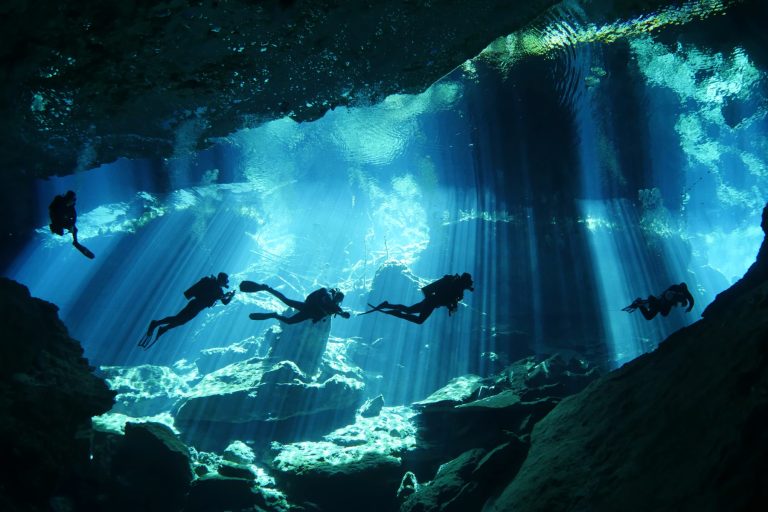
Diving in a Cenote: a unique experience only found in Mexico!
#2 YUCATAN PENINSULA: CENOTES
The Yucatán Peninsula is famous for its cenotes. Cenotes are natural freshwater sinkholes which create both open and closed caverns. Freshwater diving in a cave is an interesting experience and something you should try if you’re looking for unique dives.
Many travellers base themselves in Tulum for cenote diving, but operators run these trips from across the Riviera Maya.
Popular dive sites include:
- Dos Ojos: One of the most famous cenotes, offering crystal-clear water and stunning underwater formations. We dived here, and it was mesmerising seeing the reflections of the cavern and the glittering of trapped bubbles. There’s also a cave you can surface in with hundreds of bats!
- The Pit: Known for its deep dives (~40 metres, 120 ft) and the mesmerising light effects created by the sun’s rays penetrating the water. Advanced divers only, sorry!
- Gran Cenote: A large and popular cenote made up of a collection of caves, caverns, and some that is open air. This cenote is popular for its beautiful caves and clear visibility, making it ideal for both beginners and experienced divers.
#3 PLAYA DEL CARMEN
Just across from the island of Cozumel, Playa del Carmen is known for its bull shark dives between November and March. A sub-population of female bull sharks returns to the area every year, offering a unique shark diving experience, and an almost guaranteed shark sighting whilst diving in Central America.
Bull sharks are one of the most feared ocean predators, but they definitely don’t deserve that false reputation. Although we’d recommend Cozumel for diving in general, you may wish to set off from Playa del Carmen if you want to encounter bull sharks on your dive
It’s important to note that, when diving with bull sharks, you often don’t swim. Instead, you do a ‘static dive’ where you stay on the sandbed in your assigned place, and let the bull sharks come to you.

Turtles in Mexico
HOW MUCH DOES IT COST TO DIVE IN MEXICO?
Mexico is one of the cheapest places in Central America to go diving, especially if you stick to popular areas where competition keeps the costs down. Here are some of the prices you can expect when diving in Mexico.
- Single ocean dive: $70 to $100 USD
- Single cenote dive: $70 to $100 USD per dive. We did a double dive day in Dos Ojos with The Cenote Guy, which cost $160 USD in total, and we had an amazing time
- Bull shark dive: $80 to $150 USD
- Dive packages (5 dives): $300 to $450 USD. It’s cheaper if you book multiple dive days at the same centre. We dived with Barefoot Dive Centre in Cozumel, and their packages are on the cheaper end if you’re looking for a place to start.
- Open Water Certification: $350 to $500 USD depending on where you do this, and whether you choose a PADI or SSI Certification. On a budget? We’ve got you! Check out our guide to getting your open water scuba certification on a shoestring.
WILDLIFE TO EXPECT WHEN DIVING IN MEXICO:
OCEAN WILDLIFE
- Bull Sharks (Playa del Carmen especially)
- Turtles
- Eagle rays
- Nurse sharks
- Moray eels
- Barracudas
- Octopuses
CENOTE WILDLIFE
- Freshwater fish
- Unique cave formations
- Stalactites and stalagmites

Diving in Mexico
BEST PLACE TO GET DIVING CERTIFICATIONS IN MEXICO:
With its clear waters, vibrant marine life, and over a hundred (!) dive companies, we think Cozumel is the best place to get diving certifications in Mexico. We did our PADI Advanced Certification here.
We loved Cozumel! Just a short ferry ride from Playa del Carmen, the laid-back island of Cozumel is a world away from the tacky, touristy resort scene. But, it still takes advantage of cheap flights from the USA to nearby resort areas, making it an accessible dive destination.
Cozumel is one of the most budget-friendly places to dive in Mexico. The large number of dive centres keeps costs on the lower end for the region. The reef is beautiful and has lots to see, making it a great place to start or continue your diving journey. There are also loads accommodation and restaurant options, plenty of choices to suit all budgets and styles of travellers.

Arriving in Caye Caulker, Belize
DIVE GUIDE: BELIZE
Laid-back Belize, the only English-speaking Central American country, is another popular tropical dive destination. With the same beautiful reef as Mexico and Honduras, there’s tons to explore underwater. Divers flock to Belize’s Cayes specifically to dive in the Blue Hole, a UNESCO World Heritage Site with amazing wildlife and underwater formations.
But even if you’re planning to mainly go diving in Central America, there’s still tons to see on land. But Belize has a lot going for it. The mainland is dotted with ancient Mayan ruins like Caracol, Xunantunich, and the incredible Actun Tunichil Muknal Caves. Like most of Central America, Belize is also known for its lush rainforests and diverse wildlife. The laid-back island towns, with their ‘go slow’ motto, are full of lively local markets, and delicious seafood, making Belize not only a prime dive destination but also a great place for a well-rounded tropical holiday. Check out more things to do in Belize here.
Here are our favourite areas to dive in Belize:
BEST PLACES TO DIVE IN BELIZE:
#1 CAYE CAULKER
One of the main attractions for those looking to go diving in Central America, the Mesoamerican Barrier Reef stretches along the coast of Belize and its many cayes. These small, sandy islands sit on the surface of a coral reef, making them incredible destinations for diving and snorkelling. The waters are warm and calm, the visibility is incredible, and there’s so much to see.
Caye Caulker, a tiny jewel off the coast of Belize, is a diver’s paradise. It’s got everything going for it; sun, sea, sand, a laid-back Caribbean vibe, vibrant marine life, and tons of bars to hang out in between dives. We think Caye Caulker is the perfect place to base yourself for diving in Belize.
Popular dive sites include:
- The Blue Hole: This giant marine sinkhole, about 300 metres in diameter and 124 metres deep, is renowned for its dramatic drop-offs, underwater stalactites, and shark encounters! People visit Belize just for this. It offers a unique diving experience with its deep blue waters and underwater stalactites. However, you’ll need an advanced diving or deep diving certification to really appreciate it.
- Turneffe Atoll: A marine protected area known for being a great place to see tons od wildlife, and beautiful healthy coral. A great spot for both novice and experienced divers.
- Hol Chan Marine Reserve: A great spot for newbie or open water certified divers. Hol Chan Marine Reserve has a good mix of coral and seagrass beds, so you’ll see quite some diverse wildlife here. We saw turtles, sharks, and manatees here!
#2 AMBERGRIS CAYE
Slightly more ‘upmarket’ than Caye Caulker, Ambergris Caye is another long, narrow island off the coast of Belize. The main town, San Pedro, serves as the hub for diving activities, offering a variety of dive shops, restaurants, and accommodations.
The island has an equally laid-back atmosphere, but is a little more expensive than Caye Caulker. With easy access to the same dive sites, Ambergris Caye is a favourite spot for travellers who’d like a more upmarket experience.
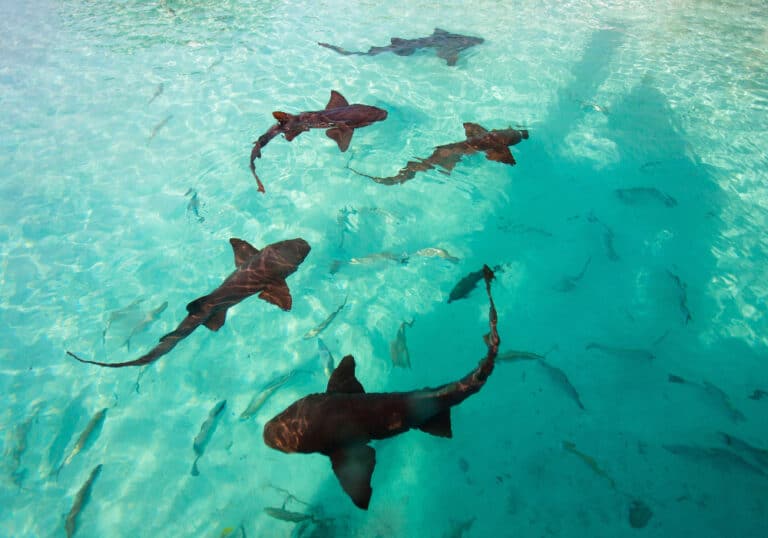
Nurse sharks, Belize
HOW MUCH DOES IT COST TO DIVE IN BELIZE?
Belize may not be the cheapest place to go diving in Central America (that award goes to Honduras!) but there’s a whole world to discover here. Here are some of the prices you can expect when diving in Belize.
- Single dive: $80 to $150 USD. We paid $160 USD for two boat dives in Caye Caulker.
- Dive packages (5 dives): $400 to $600 USD
- Great Blue Hole dive: $200 to $350 USD
WILDLIFE TO EXPECT WHEN DIVING IN BELIZE:
- Coral Reefs: Extensive coral formations, including brain coral, staghorn coral, and elkhorn coral.
- Tropical Fish: Angelfish, butterflyfish, parrotfish, and grouper.
- Nurse Sharks: Common around the reef and especially at Shark Ray Alley.
- Spotted Eagle Rays: Frequently seen gliding over the reefs.
- Sea Turtles: Hawksbill, green, and loggerhead turtles.
- Whale Sharks: Seasonally seen near Gladden Spit (April to June).
- Dolphins: Bottlenose dolphins are often spotted near the surface.
- Manatees: Can be seen in certain shallow coastal areas.
- Moray Eels: Green and spotted moray eels are common in reef crevices.
Caye Caulker is also amazing for snorkelling! Check out our ethical wildlife guides to snorkelling with sharks and swimming with manatees.

Belize’s famous Blue Hole
BEST PLACE TO GET DIVING CERTIFICATIONS IN BELIZE:
Belize isn’t the most budget-friendly destination to do any diving certifications, but it has been my favourite dive destination so far. And we can see the allure of this safe, laid-back, English-speaking island as a place to base yourself whilst you learn or continue to practise diving skills. This is the type of place where you could really fall in love with diving, the water is warm, calm, and the marine life is incredible.
If you’re looking to do your Open Water Certification, we think Caye Caulker is the best place to learn to dive in Belize. Caye Caulker is known for its excellent dive schools and dive sites suited for training. The island has access to the same sites as Ambergris Caye, but is slightly more budget-friendly when it comes to hotels and restaurants. This’ll help you save money on land.
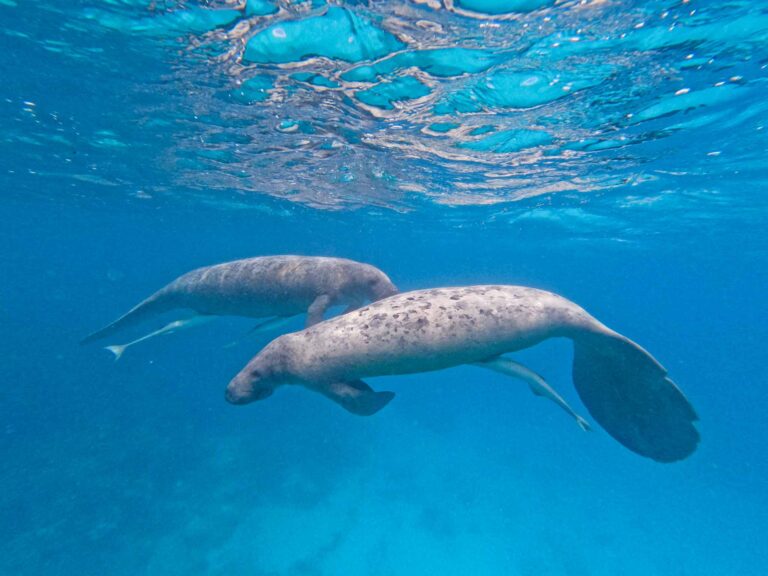
We took this on our GoPro. I always see the best wildlife during our three-minute safety stops!
DIVE GUIDE: HONDURAS
Honduras is a budget diver’s paradise, and one of the best places to go diving in Central America. Despite the country’s rocky history, diving in Honduras is really taking off, mostly due to the inexpensive Bay Islands. Honduras is also home to part of the Mesoamerican Barrier Reef. Which means (yep, you guessed it) more beautiful, clear waters, tons of marine life to look out for, and vibrant corals.
The primary diving destinations in Honduras are the Bay Islands, which include Roatán, Utila, and Guanaja. These islands offer a mix of shallow reefs, deep walls, and wrecks, enough to keep all levels of diver entertained. And whilst Honduras has a sketchy reputation, the Bay Islands are some of the safest places in the country.
If you’re looking to experience an authentic Honduras, head to the mainland. Skip San Pedro Sula, and aim for Lago Yojoa for hikes, nature, bird spotting, and coffee farms. Here are some epic things to do in Honduras!
Here are our favourite areas to dive in Honduras:
BEST PLACES TO DIVE IN HONDURAS:
#1 UTILA
Utila is one of the Bay Islands off the northern coast of Honduras, and the cheapest place to get certified for diving in Central America! Known for its extremely budget-friendly dive shops, this laid-back little island is perfect to base yourself on for a while. The waters are cloudier, with a lot of seagrass near the town. But take a boat out and you’ll find somewhat-healthy corals and great visibility.
Utila’s popularity has skyrocketed recently, and the corals aren’t as pristine as they used to be. It’s more important than ever to practise sustainable diving! Mind your fins and don’t kick or touch the corals. Additionally choose reef-safe sunscreen or better yet, cover up and avoid sunscreen until you’re finished diving.
UTILA IS WHERE WE LEARNED TO DIVE
Utila is the island we chose to visit and where we learned how to dive. The reef is teeming with colourful corals, fish, turtles and rays. We even saw a nurse shark! The waters of the Bay Islands are also known as a place where you can encounter whale sharks, although this is extremely rare. You’re more likely to see whale sharks in Mexico (here’s how!)
We didn’t want to leave and we’re sure you won’t either!
The island’s laid-back vibe, combined with its affordability and vibrant nightlife, makes it a “backpackers paradise”. It’s very much a dive all day, party all night destination, and we really enjoyed the social atmosphere here – it was easy to make friends! The colourful houses extending over the ocean, delicious restaurants, and lack of cars (Utila is easily navigable by foot, bicycle, or scooter) make the island a chill place to hang out. We think Utila is the best place to go diving in Central America for travellers looking to do lots of dive courses.
- Black Hills: An underwater seamount located southeast of Utila, Black Hills is known for its rich marine biodiversity and healthy coral formations.
- The Halliburton Wreck: This deliberately sunk cargo ship creates an artificial reef, providing an interesting wreck to explore with depths ranging from 20 to 30 metres. The perfect training dive for an advanced diving certification!
- North Side (Pinnacle): Featuring dramatic underwater landscapes with deep walls and pinnacles, the North Side offers excellent visibility and the possibility of encountering larger pelagic species, such as sharks.
- Jack Neal Point: A shallow reef dive perfect for beginners and snorkelers, Jack Neal Point boasts vibrant coral gardens and a sandy bottom.
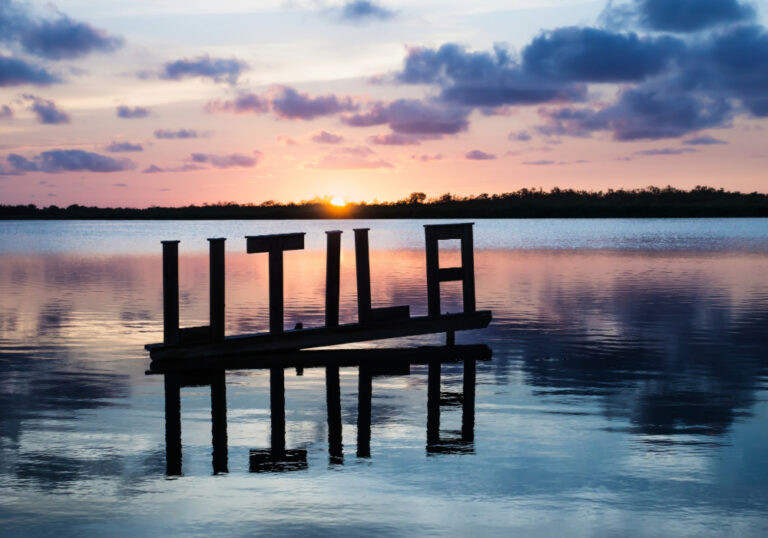
Sunsets in Utila
#2 ROATAN
Roatán, Utila’s expensive and glam twin, is the largest and most developed of Honduras’ Bay Islands. The diving is similar, with a beautiful, turquoise ocean to explore, full of dramatic underwater landscapes and tons of marine life. With a mix of deep wall diving, wrecks, and shallow reefs, like Utila, Roatán also has something to attract every level of diver.
Whilst the underwater world is mostly the same, the vibe on land could not be more different than Utila. Full of luxury resorts, Roatán caters to travellers with a little more cash to splash. However, it is Honduras, and therefore, still relatively affordable. The white sandy beaches, jungle, and opportunities for other activities like zip-lining and snorkelling make Roatán a great place to base yourself. We think groups including non-divers would be happier on Roatán, just because there’s a bit more variety in the activities on offer.
Popular Dive Sites include:
- Mary’s Place: Famous for its deep crevices and canyons, Mary’s Place offers an exciting dive experience with dramatic underwater landscapes.
- West End Wall: A steep drop-off with excellent visibility, this site is home to abundant marine life and colourful coral formations.
- Spooky Channel: Known for its eerie, narrow channels and excellent coral formations, Spooky Channel is a unique dive site that provides a bit of mystery and adventure.
- Odyssey Wreck: A large sunken freighter that has created an artificial reef, perfect for wreck diving enthusiasts looking for a deeper dive.
- El Aguila Wreck: Another popular wreck dive, the El Aguila is a sunken cargo vessel that attracts a variety of marine species and offers interesting underwater exploration.
#3 GUANAJA
Guanaja, the least developed and most secluded of the Bay Islands, is a hidden gem for divers looking for a bit of quiet. Similar to Utila and Roatán, the island’s clear waters, healthy coral reefs, and diverse marine life make for a unique and tranquil diving experience.
The smallest island of the trio, Guanaja remains relatively untouched by mass tourism. It’s a lot less crowded than Utila and Roatán, offering pristine beaches and clear waters with great visibility. On land, you’ll be spoiled by beautiful green jungle and stunning beaches. There’s less party than Utila, and fewer tourist crowds than Roatán, which allows visitors to soak up that peaceful island ambience and escape the hustle and bustle.
Popular Dive Sites include:
- Michael’s Rock: Known for its beautiful coral formations and abundant marine life, Michael’s Rock offers a vibrant and colorful dive experience.
- Jado Trader Wreck: A sunken freighter that has become an artificial reef, the Jado Trader Wreck is a fascinating site for wreck diving enthusiasts.
- Vertigo: A dramatic wall dive with excellent visibility and diverse marine life, Vertigo provides an exhilarating underwater adventure.
- Black Rock Canyon: Featuring underwater canyons and swim-throughs, this site offers an exciting and dynamic dive environment.
- The Pinnacle: A stunning underwater pinnacle covered in coral and sponges, attracting a variety of marine species and offering a unique dive experience.
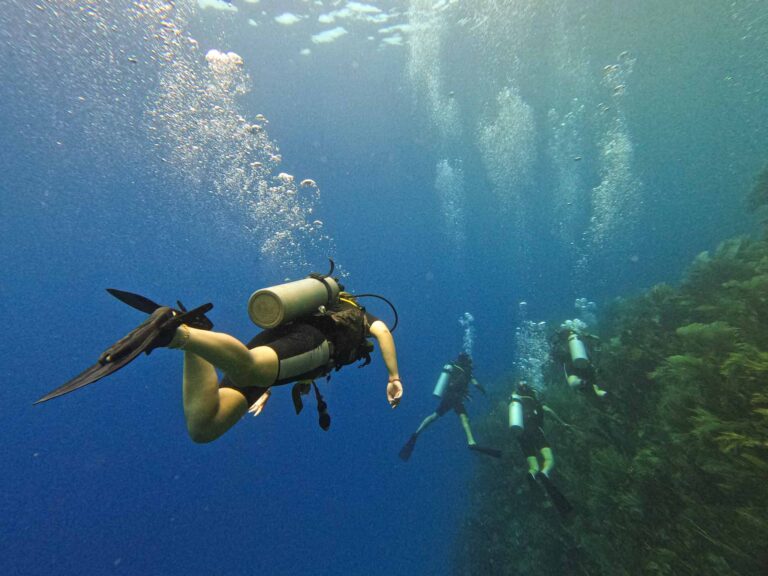
Diving in Honduras
HOW MUCH DOES IT COST TO DIVE IN HONDURAS?
All the Bay Islands have relatively budget-friendly diving. Utila will be on the cheaper side of these average costs, and Roatán and Guanaja are a little more expensive.
- Single dive: $35 to $70 USD
- Dive packages (5 dives): $150 to $300 USD
- Open Water Certification in Utila: $250 to $350 USD (up to $400 USD in Roatán and Guanaja)
- Advanced Open Water Certification in Utila: $250 to $350 USD (up to $400 USD in Roatán and Guanaja)
WILDLIFE TO EXPECT WHEN DIVING IN HONDURAS:
- Coral Reefs: Extensive barrier reefs with colorful coral formations.
- Tropical Fish: Angelfish, butterflyfish, parrotfish, and sergeant majors.
- Whale Sharks: Especially around Utila, best seen from March to April and August to September.
- Dolphins: Bottlenose and spinner dolphins are common.
- Eagle Rays: Often seen gliding over sandy areas.
- Sea Turtles: Green, hawksbill, and loggerhead turtles.
- Moray Eels: Green and spotted moray eels found in reef crevices.
- Octopuses: Often seen at night, hiding among the coral.
- Crustaceans: Lobsters, crabs, and shrimp are abundant here
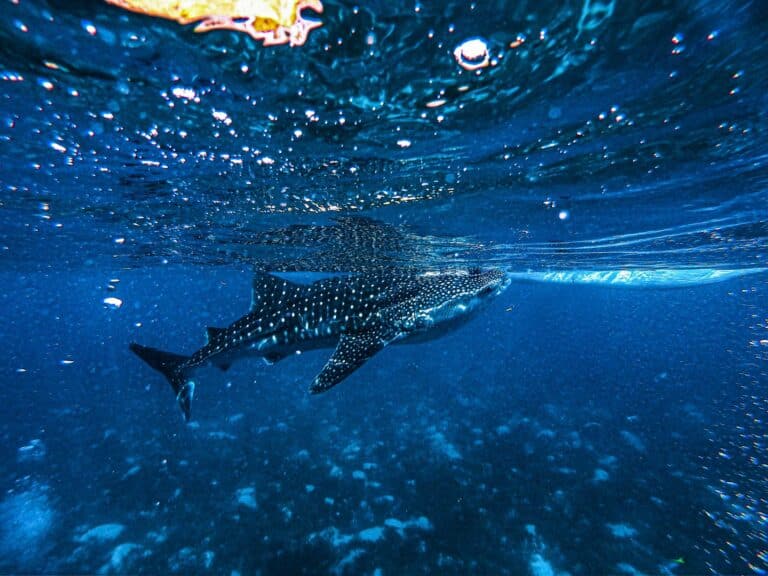
Whale Sharks in Honduras
BEST PLACE TO GET DIVING CERTIFICATIONS IN HONDURAS:
Definitely Utila. Utila is one of the cheapest places in the world to learn to dive, and the cheapest place to go diving in Central America. We spent a week here, doing our Open Water Certification and stayed for a few dives at the end, just for fun.
There are dozens of dive schools and you can find both SSI and PADI certified centres, offering a range of courses from beginner to professional levels. The low cost of certification combined with the high quality of instruction attracts many aspiring divers to the island. If you’re doing a dive course, most of the dive centres throw in a free bed in a dorm room. These are basic at best, but can help you save even more money.
Overall, Utila is a super social island with a younger backpacker crowd. If you like to party, there’s always something going on. Seven dive centres take it in turns to host a different event every night of the week, from dance parties to beer-pong tournaments, and everyone’s welcome!
If this isn’t your idea of fun, you may prefer Roatán, with all its amenities, or Guanaja, with its back-to-nature vibe. Diving courses here are a little more expensive, but not by much!
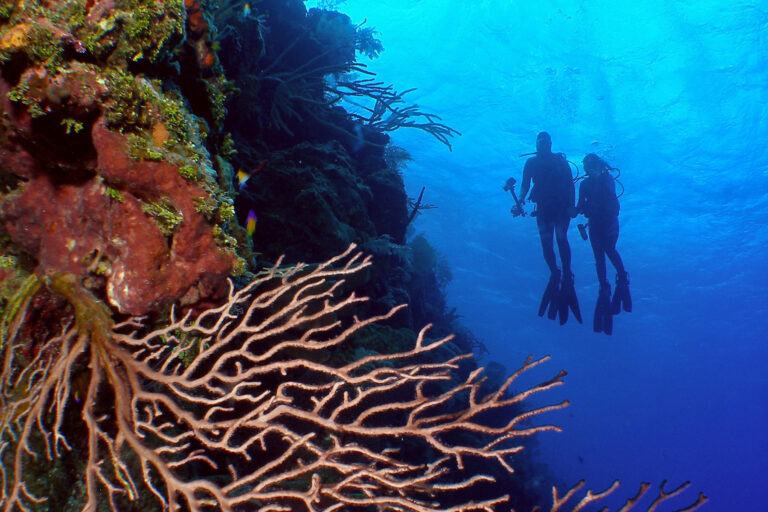
Underwater coral walls
DIVE GUIDE: GUATEMALA
Guatemala has planted itself firmly as a budget-friendly backpacker destination. There are tons of things to do! The country is famous for its well-preserved Mayan ruins, such as Tikal. There are charming colonial cities, such as Antigua, famous for cheap Spanish courses. For outdoor enthusiasts, Guatemala has some gorgeous lakes, and epic volcanoes to explore. And the indigenous culture is very much still alive here, with vibrant local markets, traditional textiles, and diverse cuisine.
While Guatemala is not as widely known for its diving as some of its Central American neighbours, there are still a few underwater experiences to be found. Most of the best locations are high altitude and freshwater diving, with Guatemala’s premiere dive area being Lake Atitlán. It’s definitely not the best country to go diving in Central America though.
Lake Atitlán is a volcanic caldera lake surrounded by mountains and traditional villages. This is a particularly popular place for freediving, with several courses on offer in the nearby villages, such as San Marcos. Be careful diving here though: I got sick from swimming in the lake!
You can check out freediving in Lake Atitlan on this website.
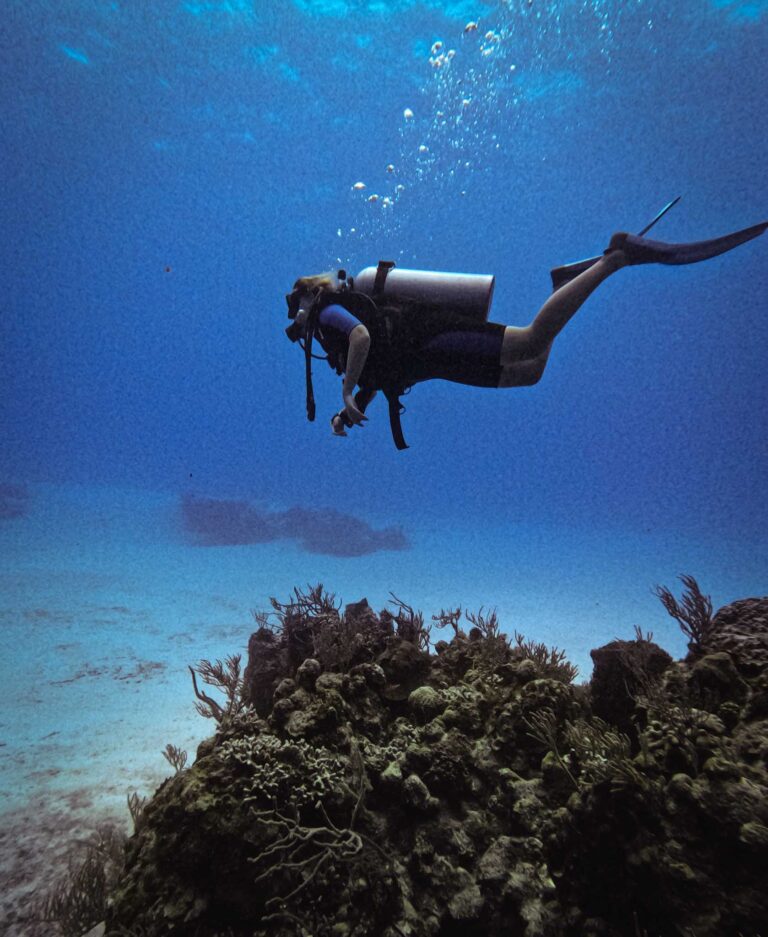
DIVE GUIDE: EL SALVADOR
El Salvador, though less renowned for diving compared to its Central American neighbours, does have some unique underwater experiences to offer along the Pacific coast.
The visibility may not always match that of the Caribbean and the temperature isn’t as warm! But there are some awesome wrecks and unique underwater geology for those who are interested. You can also dive in a volcano crater lake! Diving in El Salvador is best done during the summer months from November to May, when the sea is at it’s calmest and clearest.
What El Salvador is particularly famous for is its surf scene. If you just can’t keep away from the ocean (yes… we’re the same) you’ll want to head to El Tunco and Punta Roca. Like most of Central America, El Salvador boasts beautiful national parks, with tons of hiking, including the epic Santa Ana Volcano.
There are gorgeous little towns, like Ataco and Suchitoto, with colourful colonial buildings and brilliant street art to explore. And, the coffee scene here is thriving – you can take a tour of coffee farms and taste some bean-to-cup coffee, it’s incredible.
Here are some popular dive sites in El Salvador
- Los Cobanos: Known for its volcanic rock formations and diverse marine life. Several shipwrecks create artificial reefs at shallow depths, perfect for newer divers. Los Cobanos sometimes has a good current, perfect for drift diving.
- Lake Ilopango: This is a one-of-a-kind dive! Lake Ilopango is a volcano crater lake, with a maximum depth of 235 metres (770 ft). It was formed after a massive eruption in AD 563. Some historians and scientists believe that this eruption contributed to the fall of the Roman Empire, due to the cooling effect it had on the planet. How awesome to dive into a piece of history!

HOW MUCH DOES IT COST TO DIVE IN EL SALVADOR?
The costs of diving in El Salvador are cheap, and similar to neighbouring countries you might be looking into when planning a holiday to go diving in Central America.
- Single dive: $50 to $70 USD
- Dive packages (5 dives): $200 to $300 USD
- Open Water Certification: $415 USD
- Advanced Open Water Certification: From $300 USD
WILDLIFE TO EXPECT WHEN DIVING IN EL SALVADOR:
- Reef Fish: Parrotfish, snappers, and grunts.
- Turtles: Olive ridley and green turtles.
- Eagle Rays: Sometimes spotted near rocky outcrops.
- Dolphins: Common dolphins are often seen offshore.
- Humpback Whales: Sighted during migration (December to April).
- Sharks: Various species in deeper waters, though sightings are rare.
- Octopuses: Often hiding among rocky reefs.
- Crustaceans: Lobsters and crabs, particularly in rocky areas.
BEST PLACE TO GET DIVING CERTIFICATIONS IN EL SALVADOR:
If you’re willing to brave poorer visibility and cooler temperatures, doing an open water certification in El Salvador can be an enjoyable experience. And the best place to start is definitely Los Cobanos. With its diverse marine life, shipwrecks, and interesting underwater geology, Los Cóbanos is a great place to start your diving journey. Check out El Salvador Diving for more information on courses, prices, and dive sites.

DIVE GUIDE: NICARAGUA
Working our way south, we arrive in Nicaragua. Nicaragua offers diverse diving experiences in both the Pacific Ocean and the Caribbean Sea.
The Pacific coast provides a rugged diving experiences with underwater volcanic rock formations. It’s not as clear and warm as the Caribbean, but there’s still a lot to see. And the best bit? It’s easily accessible, close to beloved traveller towns, such as San Juan del Sur, and Granada.
Whilst the main tourist trail will take you up the Pacific coast of Nicaragua, the country offers some excellent diving for those willing to get off the beaten track… literally! The southern tip of the Mesoamerican Barrier Reef just about reaches the Corn Islands. These tiny tropical islands aren’t as well known as Honduras’ Bay Islands, but provide a similar underwater atmosphere with an idyllic, budget-friendly, island paradise on land. We’ve heard that they’re one of the best places to go diving in Central America.
On land, Nicaragua is known for its surf scene! Surfing is incredibly popular and very cheap on the Pacific coast, with towns such as San Juan attracting surfers from across the globe. Nicaragua also has some pretty old colonial towns (my favourites being Granada and León). Being on the Pacific Ring of Fire, there are tons of volcanoes to explore, from hiking to the active Masaya, boarding down the active volcano, Cerro Negro, and biking around the twin volcanoes of Ometepe Island. If you’re looking for some tips, here are our favourite things to do in Nicaragua!
BEST PLACES TO DIVE IN NICARAGUA:
#1 THE CORN ISLANDS
The Corn Islands are located about 50 miles east off the Caribbean coast of Nicaragua. This makes them very much ‘off the beaten path’ but the Corn Islands offer some truly excellent reef diving for travellers willing to make the trek.
BIG CORN ISLAND
Big Corn Island is the more developed of the two, featuring a small airport, hotels, cafés and restaurants. Underwater conditions are clear, with vibrant coral reefs and small canyons, and most dives are between 15 to 25 metres (50 to 80 ft).
LITTLE CORN ISLAND
However, if the boats are going, I wholly recommend heading out to the smaller, Little Corn Island. This island is a step back in time and is a budget traveller’s dream. You can walk a loop of the island in just under an hour. With no motor vehicles, patchy electricity, and limited internet, Little Corn Island is the perfect opportunity for a week of diving and digital detox. The underwater world is similar, but the vibes on land are so much more peaceful. If you want to know more about diving in Central America, particularly the Corn Islands, this post is a great place to start.
Here are some excellent dive sites near the Corn Islands:
- White Holes: A series of sandy patches surrounded by coral formations, White Holes is teeming with marine life such as lobsters, moray eels, and schools of colorful fish. It’s a great site for both beginners and experienced divers.
- Shark Hole: This site is known for its regular sightings of nurse sharks and other large fish. The dramatic underwater landscape features caves and crevices to explore.
- Yellowtail: A vibrant coral reef teeming with tropical fish, Yellowtail is a beautiful dive site with excellent visibility. It’s perfect for photographers and those looking to enjoy a colorful underwater scene.
- Pinnacles: Featuring underwater pinnacles and rock formations, this site is home to a variety of marine life, including barracudas, groupers, and occasionally, hammerhead sharks.
#2 SAN JUAN DEL SUR
Located on the Pacific Coast of Nicaragua, San Juan del Sur is primarily a surf town (and the place where we learned to surf). But of course, you can dive here too. You just have to track down an operator. And to save you some time, we’ll tell you that the only dive centre here is Dive Nicaragua.
The diving here isn’t as clear, warm, or pristine as on the Caribbean side, but there are still some interesting things to see. A handful of rocky islets create a great habitat for Pacific fish species, but the main underwater attraction is a sunken Russian ship located close to the La Paloma Island.
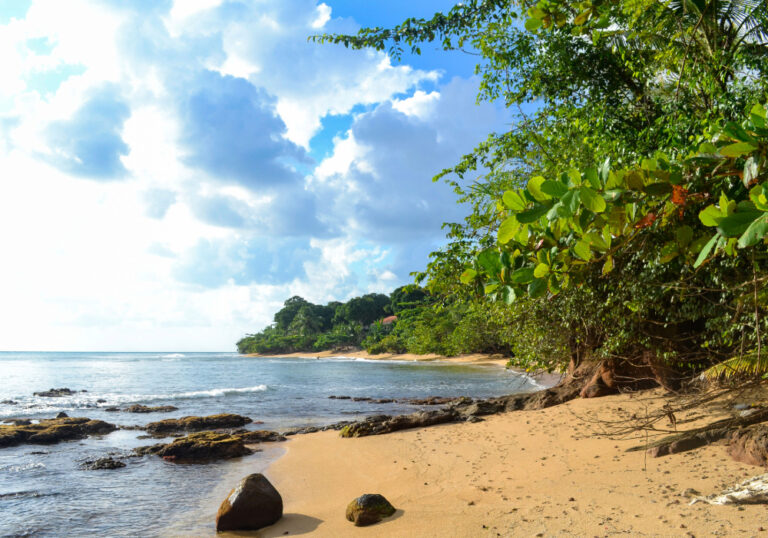
Little Corn Island, Nicaragua
HOW MUCH DOES IT COST TO DIVE IN NICARAGUA?
- Single dive: $50 – $80
- Dive packages (5 dives): $200 – $350
WILDLIFE TO EXPECT WHEN DIVING IN NICARAGUA:
PACIFIC COAST
- Reef Fish: Includes jacks, snappers, and grunts.
- Turtles: Olive ridley turtles, especially during nesting season.
- Dolphins: Bottlenose and common dolphins seen offshore.
- Humpback Whales: Seen during migration (December to March).
- Sharks: Various species, though usually in deeper waters.
CARIBBEAN COAST:
- Coral Reefs: Hard and soft corals, including brain coral and fan coral.
- Tropical Fish: Snappers, grunts, and parrotfish.
- Nurse Sharks: Common in shallow reef areas.
- Eagle Rays: Frequently seen gliding through the water.
- Sea Turtles: Hawksbill and green turtles.
- Dolphins: Bottlenose dolphins, especially near the Corn Islands.
- Moray Eels: Often spotted in crevices among the reefs.
- Crustaceans: Lobsters and crabs, particularly in rocky areas.
BEST PLACE TO GET DIVING CERTIFICATIONS IN NICARAGUA:
If you’re in Nicaragua, and looking to either learn to dive, or pick up some new skills, we recommend making the trip to the Corn Islands. Both Big Corn and Little Corn have dive shops offering PADI certification courses.
Little Corn Island, in particular, is popular for diving certifications. With a laid-back atmosphere, gorgeous dive sites and beautiful beaches to relax on before and after your dive, you might not want to leave!
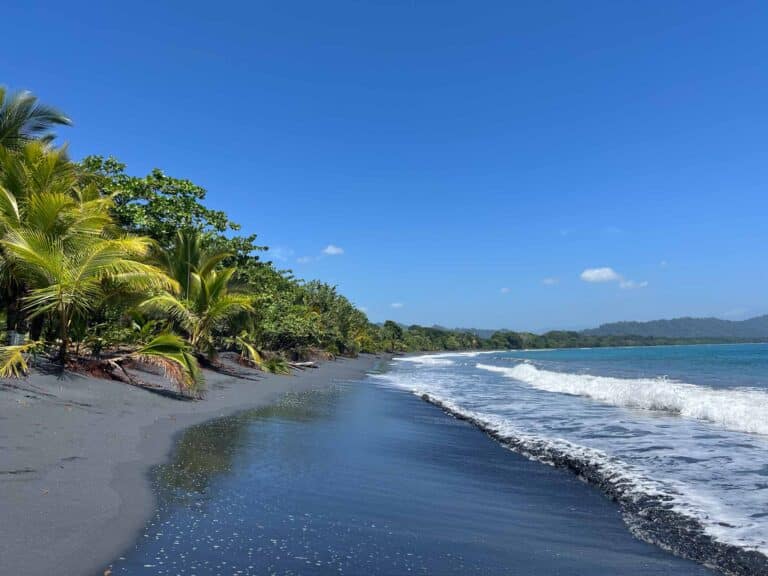
Black sand beaches, Costa Rica
DIVE GUIDE: COSTA RICA
Costa Rica is known for its incredible biodiversity, both above and below the water. The Pacific coast offers world-class diving with sites like the Catalina Islands and the Bat Islands. These islands are known for frequent dive encounters large animals: we’re talking manta rays, dolphins and sharks. The Caribbean side, though less developed for diving than Mexico, Belize, Honduras or Nicaragua, also offers rich marine life and beautiful coral formations.
Above land, Costa Rica is (of course) famous for its eco-tourism, with numerous national parks, volcanoes, and rainforests to explore. There are so many opportunities for adventure activities, such as zip-lining, hiking, exploring swinging jungle bridges, and climbing volcanoes. The country’s well-developed infrastructure and commitment to conservation make it a top destination for nature lovers. If you’re looking for inspiration, here our the best things to do in Costa Rica
BEST PLACES TO DIVE IN COSTA RICA:
#1 PACIFIC COAST
- Catalina Islands: Located off the coast of the Guanacaste province, the Catalina Islands are a collection of 20 islands formed by volcanic activity. They are considered one of the best dive sites in Costa Rica, renowned for their rich marine life. There are giant manta rays, white-tip reef sharks, and large schools of fish, with generally good visibility
- Cocos Island: A UNESCO World Heritage Site, Cocos Island is often considered one of the best diving spots in the world. Located ~550 kilometres off the Pacific coast, you’ll likely see hammerhead sharks, whale sharks, manta rays, and dolphins here. It’s expensive, and requires a liveaboard trip, but it is well worth the journey!
- Bat Islands: Situated in the Santa Rosa National Park, the Bat Islands are famous for bull shark encounters and also feature large schools of jacks, manta rays, and the occasional whale shark. The dives here are more challenging due to strong currents, making them suitable for advanced divers.
#2 CARIBBEAN COAST
The Caribbean coast doesn’t have quite so much infrastructure for diving as the Pacific, but there are still a few dive sites to be found:
- Cahuita National Park: Generally calm waters, suitable for divers of all levels. Visibility can vary but is often good, especially during the dry season. Expect to see A variety of coral species, including brain coral and elk horn coral. Marine life includes angelfish, parrotfish, barracudas, nurse sharks, and sea turtles
- Gandoca-Manzanillo Wildlife Refuge: Suitable for beginners and experienced divers. Best diving conditions are typically found between March and May. Expect to see coral reefs, seagrass beds, and mangroves. Species include manatees, dolphins, and numerous tropical fish
Uvita Island (Isla Uvita): Good visibility and relatively calm waters, with parrotfish, angelfish, and occasionally, dolphins. The area also has historical significance as it was visited by Christopher Columbus on his final voyage.
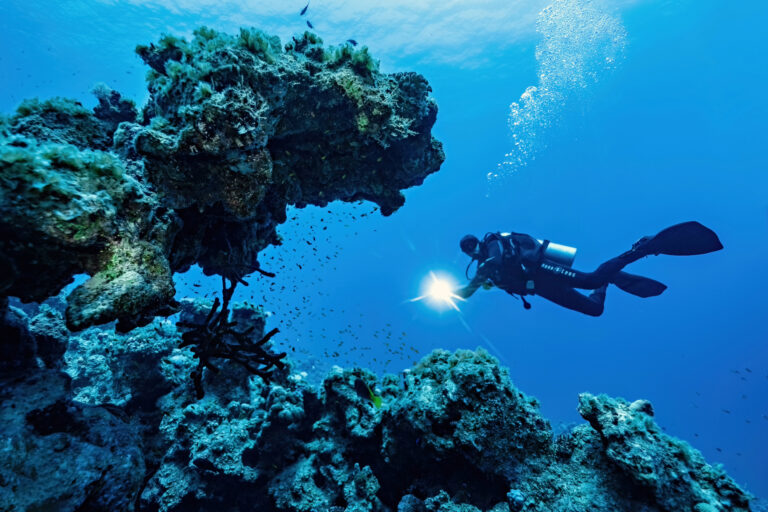
Diving!
HOW MUCH DOES IT COST TO DIVE IN COSTA RICA?
Costa Rica is the most expensive country in Central America, which makes it the most expensive place to go diving in Central America. However, they do really care for their reefs and their wildlife!
- Single dive: $75 to $100 USD
- Dive packages (5 dives): $350 to $500 USD
- Cocos Island liveaboard: $5,000 to $6,000 for a week
WILDLIFE TO EXPECT WHEN DIVING IN COSTA RICA:
PACIFIC COAST
- Whale Sharks: Occasionally seen, particularly around Cocos Island.
- Hammerhead Sharks: Large schools around Cocos Island.
- Manta Rays: Giant mantas are common, especially around the Gulf of Papagayo.
- White-Tip Reef Sharks: Often resting on sandy bottoms.
- Humpback Whales: Seen during migration (July to November).
- Sea Turtles: Olive ridley, green, and leatherback turtles.
- Dolphins: Spotted, common, and bottlenose dolphins.
- Reef Fish: Includes parrotfish, angelfish, and jacks.
CARIBBEAN COAST:
- Coral Reefs: Hard corals like brain coral and elkhorn coral.
- Tropical Fish: Snappers, angelfish, and grunts.
- Sea Turtles: Green and hawksbill turtles.
- Eagle Rays: Commonly seen near the reefs.
- Manatees: Occasionally sighted in protected areas.
- Dolphins: Bottlenose dolphins are frequent visitors.
- Crustaceans: Lobsters and crabs are common
BEST PLACE TO GET DIVING CERTIFICATIONS IN COSTA RICA:
Costa Rica is a great dive destination. But, this is the most expensive country in Central America, and the prices you’ll pay to learn to dive reflect that.
Playas del Coco is one of the top destinations for diving on Costa Rica’s Pacific coast. The location is ideal for newbie divers due to its proximity to excellent dive sites such as the Catalina Islands and Bat Islands. These sites are renowned for their diverse marine life, including giant manta rays and bull sharks! We’d be hard-pressed to think of a cooler place to learn to dive…

Hammerhead sharks, Costa Rica
DIVE GUIDE: PANAMA
Long and thin, Panama has oodles of coastline, both on the Pacific and Caribbean coasts. The Caribbean side, particularly around Bocas del Toro and the San Blas Islands, has clear, calm water with beautiful coral reefs and lots of underwater activity. The Pacific side, including Coiba National Park, offers rugged underwater landscapes, excellent wreck diving, and good chances of seeing sharks and manta rays. We think Panama is a super interesting place for varied diving in Central America.
Unlike Mexico, Belize, and Honduras, Panama’s dive sites remain relatively uncrowded. Yet the country has rich marine biodiversity, with everything from tiny nudibranchs to large whale sharks. Those looking for variety will find it, with the Caribbean and Pacific oceans just a day’s drive from each other.
On land, Panama is known for its iconic Panama Canal, a must-see if you’re in the country. Like the rest of Central America, Panama also has lush rainforests, areas of cloud forest and beautiful beaches on both coasts. Surfing, hiking, and bird watching are popular activities. Check out our top tips and in-depth guides to Panama here.
BEST PLACES TO DIVE IN PANAMA:
#1 PACIFIC COAST
- Bocas del Toro and the nearby islands are a popular destination for divers looking for a warm, turquoise ocean during the day, and excellent nightlife after dark. Like most Caribbean sites, expect coral gardens, sea turtles, nurse sharks and tropical fish. Calm and warm waters year-round make this an ideal site for beginners. And it’s not all about diving in Central America, Bocas has tons of party too!
- Portobelo is known for its rich history and underwater treasures. Legend has it that Christopher Colombus landed here before setting out to explore the Americas. There are shipwrecks to explore, each with an abundance of marine life, including eagle rays and barracudas. Diving conditions are generally good, with excellent visibility and mild currents, suitable for all levels of divers.
#2 CARIBBEAN COAST
- Coiba National Park: Often referred to as the “Galápagos of Central America,” Coiba National Park is a UNESCO World Heritage site. You’re almost guaranteed to see turtles here, and you can also expect to encounter whale sharks, hammerhead sharks, manta rays, dolphins, and a plethora of fish species. The coast around Coiba has generally good visibility, and strong currents make the area suitable for drift diving.
- Isla Taboga: the “Island of Flowers,”, has a range of dive sites close to Panama City. There are a lot of underwater rock formations to explore, and the usual reef fish. Generally, good visibility and mild currents make the area accessible for all levels.
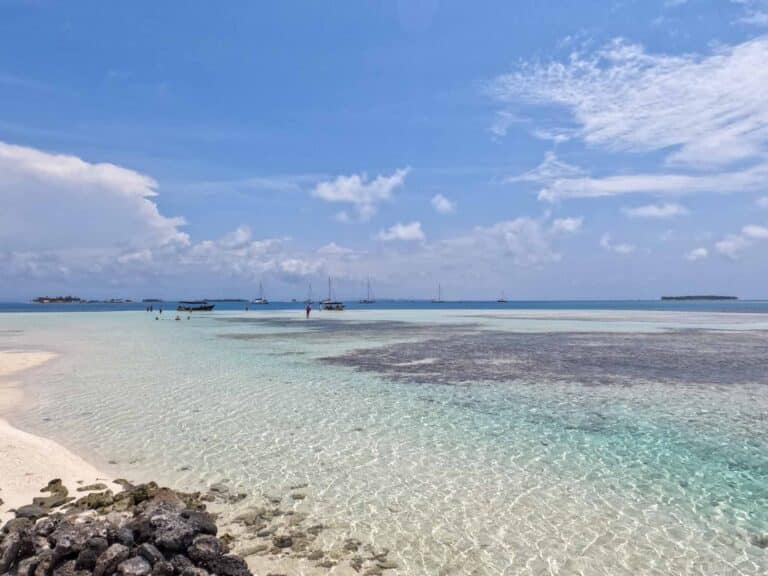
HOW MUCH DOES IT COST TO DIVE IN PANAMA?
- Single dive: $60 – $90
- Dive packages (5 dives): $250 – $400
- Coiba liveaboard: $3,000 – $4,000
WILDLIFE TO EXPECT WHEN DIVING IN PANAMA:
CARIBBEAN COAST:
- Coral Reefs: Various species of hard and soft corals.
- Tropical Fish: Parrotfish, angelfish, butterflyfish, damselfish, and wrasse.
- Sea Turtles: Green sea turtles and hawksbill turtles.
- Nurse Sharks: Often seen resting on the seafloor.
- Eagle Rays: Graceful swimmers often spotted gliding through the water.
- Dolphins: Bottlenose dolphins are occasionally seen near dive sites.
- Seahorses: Hidden among the coral, these tiny creatures are a delight to spot.
PACIFIC COAST:
- Whale Sharks: Seen seasonally, especially around Coiba.
- Hammerhead Sharks: Common in deeper waters and near seamounts.
- Manta Rays: Giant manta rays are frequently encountered, particularly near seamounts.
- White-Tip Reef Sharks: Often seen resting on the sandy bottoms.
- Humpback Whales: Seen during their migration season (July to October).
- Sea Lions: Playful and curious, especially around Isla de Coiba.
- Barracudas: Often spotted in schools near reefs.
- Turtles: Olive ridley and Pacific green turtles.
BEST PLACE TO GET DIVING CERTIFICATIONS IN PANAMA:
Panama is an ideal destination if you’re looking to learn. how to dive, or continue your training. Bocas del Toro on the Caribbean coast is a top spot for novices. The warm waters and excellent visibility make it a comfortable place to learn how to dive for the first time.
But Bocas del Toro and the surrounding islands can be party party! If you’re looking for a quieter experience, Portobelo on the Caribbean coast offers shallow reefs and shipwrecks, ideal for novice divers. Similar to other dive destinations in Central America, PADI and SSI certifications, typically cost between $350 and $450 USD.
On the Pacific side, Santa Catalina provides access to Coiba National Park, a UNESCO World Heritage Site known for its rich marine biodiversity. It’s a little more expensive to dive here, with certification courses costing around $400 to $500 USD. However, the area is perfect for beginners, offering the chance to swim with schools of fish, turtles, and sharks in relatively calm conditions.

So, that’s the ultimate guide to diving in Central America. If you have any questions, do reach out either in the comments box, or on our Instagram. Enjoy your travels and happy diving!
LIKE IT? PIN IT!
SAVE THIS POST TO YOUR PINTEREST BOARD TO COME BACK LATER

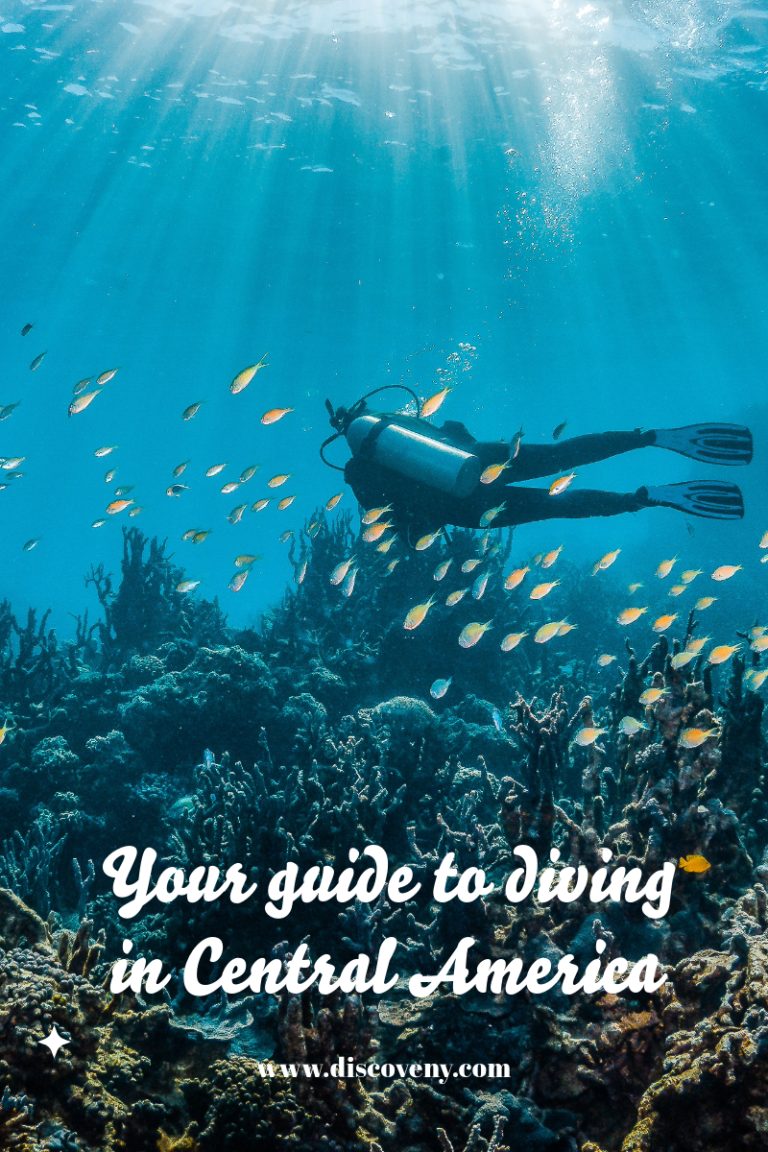
Follow our daily adventures on Facebook and Instagram
Disclaimer: The information and advice provided in this blog are the author’s opinions and based on their personal experiences. All information was accurate at the time of writing. However, things can change quickly, so always double-check current conditions and guidelines before setting out. Remember, your travels and safety are your own responsibility, and this blog can not be held responsible for anything that might happen on your adventures! Always exercise caution and good judgment. Oh, and don’t forget to get travel insurance! Happy travels!
This post may contain affiliate links (yay for transparency!) This means that I will earn a small commission, at no additional cost to you, if you click the link and choose to buy the product. I only link to stuff I have personally bought and found useful and never endorse crap. Your support helps keep the site going, thank you!
Alice
Alice is a UK travel blogger who advocates sustainable travel and being more eco-conscious on a budget. She loves coffee, her houseplants and summiting mountains.
You May Also Like

Catching Chicken Buses in Central America: 17 Things You Should Know
October 7, 2023
10 reasons to visit Central America during the rainy season
September 21, 2024